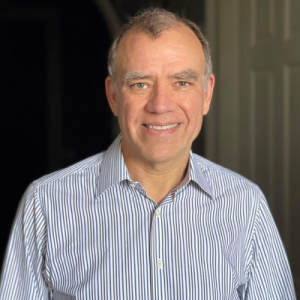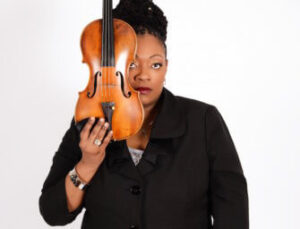Podium Note Mozart & More
Hibernian Hall
August 11, 2023
by Christopher Wilkins
Tonight is a tale of two traditions and two soloists.
The program begins with European works from the Classical era, and concludes with music from Latin cultures, including works from Puerto Rico and Spain. Our soloists are virtuosos on two different string instruments: violin and guitar. We thank both artists for their generous partnering with the Landmarks Orchestra, and for their leadership in Boston’s musical community.
The 1816 premiere of Giacomo Rossini’s The Barber of Seville was a standout achievement in his career, even within a string of extraordinary successes. By 1816, he was already the most performed composer in operatic history. Audiences lapped up his music like champagne, to which his sparkling creations were often compared. The Barber of Seville was composed in just under three weeks. It was his seventeenth opera, out of a catalogue that eventually grew to forty. Its overture—which he also used in two other operas—was an instant hit, and has long since become a cornerstone on the symphonic repertoire.
Mariana Green-Hill has contributed to the Boston musical scene in extraordinary and unique ways: as soloist, chamber musician, pedagogue, and institutional leader. She has been a featured artist and collaborator with the Boston Landmarks Orchestra for many years, most recently leading the members of the Four Strings Academy at the Hatch Shell on August 2. Tonight, she introduces an important work by a fascinating and unjustly neglected composer.
Joseph Bologne—subject of the 2022 feature-length film Chevalier—was one of the most broadly gifted figures of the 18th century. Born on the Caribbean island of Guadeloupe to a wealthy French planter father and an islander mother whom he enslaved, Joseph was sent to school in Paris at the age of seven. He quickly excelled in virtually everything, including music, dance, horsemanship, and fencing. According to Antoine La Boëssière’s 1818 treatise on fencing, “At fifteen [Bologne’s] progress was so rapid, that he was already beating the best swordsmen, and at seventeen developed the greatest speed imaginable.” Winning a contest against a renowned master, Bologne was appointed gendarme in the royal guard by King Louis XVI. He assumed his father’s noble suffix, becoming the “Chevalier de Saint-Georges.” Bologne was also one of the greatest violinists of his day. Among other honors, in 1773 he assumed the directorship of the Concert des Amateurs, one of the leading orchestras in Europe. His compositions range from chamber music to concertos and symphonies to stage works, many of which, including tonight’s concerto, were for his own use as soloist. His performances were said to astound and enrapture the public. When the French Revolution erupted, Bologne’s ties to the court—including his closeness to Marie-Antoinette—were subject to scrutiny and litigation, serving to undermine his career.
When Wolfgang Amadè Mozart needed a symphonic work to introduce in Vienna in 1782 on short notice, he wrote to his father in Salzburg, requesting that he send a serenade composed a few months earlier for a ceremony elevating his friend, Sigmund Haffner, to the nobility. When the score arrived in the post, Mozart was astonished at its quality, and didn’t recall a note of it, he had composed it in such haste. He had written the serenade for entertainment purposes, as background music. For the Viennese, he refashioned it as a symphony, making it both grander and more compact. He dropped two movements—an opening march and one of two minuets—and added flutes and clarinets. The opening gesture of the first movement, with its two-octave leap and athletic rhythm, sets the tone for the whole symphony, a work of great power and vigor. The second and third movements combine a constant pulsing vitality with Mozart’s most lyrical symphonic writing to date. The final movement, marked Presto, foreshadows the dazzling bustle of his overture to the Marriage of Figaro, composed four years later. When Mozart sent the original serenade to his father, he included an instruction that the finale should be played “as fast as possible.”
Puerto Rican-born composer Roberto Sierra was elected to the American Academy of Arts and Letters in 2021. In 2017, he was awarded the Tomás Luis de Victoria Prize, the highest honor given in Spain to a composer of Spanish or Latin American origin. His works have been commissioned and performed by orchestras and ensembles all over the world, including the Boston Symphony, Philadelphia Orchestra, the New York Philharmonic, the Tonhalle Orchestra of Zurich, the St. Lawrence String Quartet, and many others. Guaracha is the fifth and final movement of his Serenata, a work blending elements of the 18th and 19th-century dance suite with Latin American rhythms and contemporary harmonies. The Guaracha dance originated in Cuba, but soon became popular in Puerto Rico, where it took on its own national style, always celebratory and playful. Sierra’s setting evokes childhood parties, with ebullient interactions occasionally disrupted by gleeful chaos.
We are thrilled to collaborate for the first time with renowned Boston-based artist Zaira Meneses. Soloist, chamber musician, and prize winner in international competitions, she has become a favorite on international recital series and festivals. Ms. Meneses is a highly regarded pedagogue, serving on the faculty of the New England Conservatory of Music and at the Walnut Hill School. She is also co-founder of Boston GuitarFest, along with her spouse, and fellow classical guitarist, Eliot Fisk. Together they have recently established the Eliot Fisk Guitar Academy, which provides a cross-disciplinary musical education to students of all ages and backgrounds.
Spanish composer Joaquín Rodrigo was blinded by childhood diphtheria from the age of 3. He credited his lifelong love of music to that apparent misfortune. And his life was a long one; he lived to the age of ninety-eight. Along with his twentieth-century contemporaries Manuel de Falla, Isaac Albéniz, and Enrique Granados, Rodrigo developed a distinctly Spanish musical style, one influenced by his French musical education but rooted in traditions dating back centuries on the Iberian peninsula: Spanish folk music and dance, vocal stylings connected to North African traditions, and echoes of traditional flamenco art. Rodrigo composed the Concierto de Aranjuez in 1939, inspired by the beauty of the gardens at the Royal Palace of Aranjuez, originally built in the 16th century by Philip II. The composer described the work as evoking the gardens’ “fragrance of magnolias, the singing of birds, and the gushing of fountains.”
 CHRISTOPHER WILKINS was appointed Music Director of the Boston Landmarks Orchestra in the spring of 2011. Since then, he has expanded the orchestra’s mission of making great music accessible to the whole community. He has also helped develop the orchestra’s Breaking Down Barriers initiative, making accessibility a priority in all aspects of the orchestra’s activities.
CHRISTOPHER WILKINS was appointed Music Director of the Boston Landmarks Orchestra in the spring of 2011. Since then, he has expanded the orchestra’s mission of making great music accessible to the whole community. He has also helped develop the orchestra’s Breaking Down Barriers initiative, making accessibility a priority in all aspects of the orchestra’s activities.


